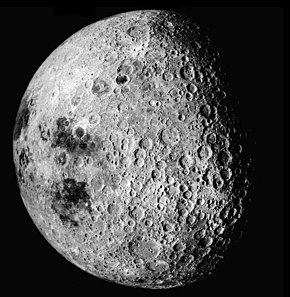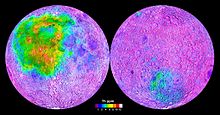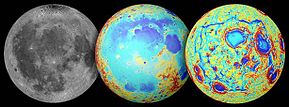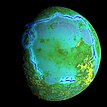Origin of the Moon

Theorigin of the Moonis usually explained by a Mars-sized body striking theEarth,creating adebris ringthat eventuallycollectedinto a singlenatural satellite,theMoon,but there are a number of variations on thisgiant-impact hypothesis,as well as alternative explanations, and research continues into how the Moon came to be formed.[1][2]Other proposed scenarios include captured body, fission, formed together (condensation theory,synestia),planetesimalcollisions (formed from asteroid-like bodies), and collision theories.[3]
The standard giant-impact hypothesis suggests that a Mars-sized body, calledTheia,impacted the proto-Earth, creating a largedebris ringaround Earth, which thenaccretedto form the Moon. This collision also resulted in the 23.5°tilted axisof the Earth, thus causing theseasons.[1][irrelevant citation]The Moon'soxygen isotopicratios seem to be essentially identical to Earth's.[4]Oxygen isotopic ratios, which may be measured very precisely, yield a unique and distinct signature for eachSolar Systembody.[5]If Theia had been a separateprotoplanet,it probably would have had a different oxygen isotopic signature than proto-Earth, as would the ejected mixed material.[6]Also, the Moon'stitanium isotoperatio (50Ti/47Ti) appears so close to the Earth's (within 4 parts per million) that little if any of the colliding body's mass could likely have been part of the Moon.[7]
Formation[edit]
"One of the challenges to the longstanding theory of the collision, is that a Mars-sized impacting body, whose composition likely would have differed substantially from that of Earth, likely would have left Earth and the moon with different chemical compositions, which they are not."
—NASA[1]

Some theories have been stated that presume the proto-Earth had no large moons early in the formation of the Solar System, 4.425 billion years ago, Earth being basically rock and lava.Theia,an earlyprotoplanetthe size of Mars, hit Earth in such a way that it ejected a considerable amount of material away from Earth. Some proportion of these ejectaescapedinto space, but the rest consolidated into a single spherical body in orbit about Earth, creating the Moon.
The hypothesis requires a collision between a proto-Earth about 90% of the diameter of present Earth, and another body the diameter ofMars(half of the terrestrial diameter and a tenth of its mass). The latter has sometimes been referred to asTheia,the name of the mother ofSelene,the MoongoddessinGreek mythology.This size ratio is needed in order for the resulting system to have sufficientangular momentumto match the current orbital configuration. Such an impact would have put enough material into orbit around Earth to have eventually accumulated to form the Moon.
Computer simulationsshow a need for a glancing blow, which causes a portion of the collider to form a long arm of material that then shears off. The asymmetrical shape of the Earth following the collision then causes this material to settle into an orbit around the main mass. The energy involved in this collision is impressive: possibly trillions of tonnes of material would have been vaporized and melted. In parts of the Earth, the temperature would have risen to 10,000 °C (18,000 °F).
The Moon's relatively smallironcore (compared to otherrocky planetsand moons in the Solar System) is explained by Theia's core mostly merging into that of Earth. The lack ofvolatilesin the lunar samples is also explained in part by the energy of the collision. The energy liberated during the reaccretion of material in orbit around Earth would have been sufficient to melt a large portion of the Moon, leading to the generation of amagma ocean.
The newly formed Moon orbited at about one-tenth the distance that it does today, and spiraled outward because oftidal frictiontransferring angular momentum from the rotations of both bodies to the Moon's orbital motion. Along the way, the Moon's rotation becametidally lockedto Earth, so that one side of the Moon continually faces toward Earth. Also, the Moon would have collided with and incorporated any small preexisting satellites of Earth, which would have shared the Earth's composition, including isotopic abundances. The geology of the Moon has since been more independent of the Earth.
A 2012 study on the depletion ofzincisotopes on the Moon found evidence for volatile depletion consistent with the giant-impact origin for Earth and the Moon.[8]In 2013, a study was released that indicated that water in lunar magma is indistinguishable from that incarbonaceous chondritesand nearly the same as that of Earth inisotopic composition.[9][10][11]
Derivatives of the hypothesis[edit]
Although the giant-impact hypothesis explains many aspects of the Earth–Moon system, there are still a few unresolved problems, such as the Moon's volatileelementsnot being as depleted as expected from such an energetic impact.[12]
Another issue is lunar and Earth isotope comparisons. In 2001, the most precise measurement yet of theisotopic signaturesofMoon rockswas published.[4]Surprisingly, theApollolunar samples carried an isotopic signature identical to Earth rocks, but different from other Solar System bodies. Because most of the material that went into orbit to form the Moon was thought to come from Theia, this observation was unexpected. In 2007, researchers from Caltech showed that the likelihood of Theia having an identical isotopic signature as the Earth is very small (less than 1 percent chance).[13]Published in 2012, an analysis of titanium isotopes in Apollo lunar samples showed that the Moon has the same composition as Earth,[14]whichconflictswith the Moon forming far from Earth's orbit.
Merger of two planets[edit]
To help resolve these problems, a theory published in 2012 posits that two bodies—each five times the size of Mars—collided, then recollided, forming a large disc of mixed debris that eventually formed Earth and the Moon.[1]
Immediate origin of the Moon as a post-impact satellite[edit]
The Moon is traditionally thought to have coalesced from the debris ejected by a giant impact onto the early Earth. However, such models struggle to explain the similar isotopic compositions of Earth and lunar rocks at the same time as the system's angular momentum, and the details of potential impact scenarios are hotly debated. Above a high resolution threshold for simulations, a study published in 2022 finds that giant impacts can immediately place a satellite with similar mass and iron content to the Moon into orbit far outside Earth'sRoche limit.Even satellites that initially pass within the Roche limit can reliably and predictably survive, by being partially stripped and then torqued onto wider, stable orbits. Furthermore, the outer layers of these directly formed satellites are molten over cooler interiors and are composed of around 60% proto-Earth material. This could alleviate the tension between the Moon's Earth-like isotopic composition and the different signature expected for the impactor. Immediate formation opens up new options for the Moon's early orbit and evolution, including the possibility of a highly tilted orbit to explain the lunar inclination, and offers a simpler, single-stage scenario for the origin of the Moon.[15]
Multiple impacts[edit]
In 2004, Russian astrophysicistNikolai Gorkavyiproposed a novel model titled the multiple large asteroid impacts model,[16][17]which found support from a notable group of Russian astronomers in 2013[18]and later, in 2017, by planetary researchers atWeizmann Institute of Sciencein Rehovot, Israel.[19]In general terms, the main idea of the model suggests that the Moon was formed as a result of a violent rain of large asteroids (1–100 km) that repeatedly hammered the fledgling Earth over millions of years. Such a series of smaller impacts, which were likely more common in the early Solar System, could blast enough rocky Earth debris into orbit to form a protosatellite disk which later forms into a small moonlet.[17][19]As repeated impacts created more balls of debris, the moonlets could merge over time into one large moon.[17][19]
Synestia hypothesis[edit]
In 2018 researchers atHarvardand theUC Davisdeveloped computer models demonstrating that one possible outcome of aplanetary collisionis that it creates asynestia,a mass of vaporized rock and metal which forms abiconcave discextending beyond the lunar orbit. The synestia will eventually shrink and cool to accrete the satellite and reform the impacted planet.[20]
Other hypotheses[edit]
| Density[21] | |||||||
| Body | Density g/cm3 | ||||||
|---|---|---|---|---|---|---|---|
| Mercury | 5.4 | ||||||
| Venus | 5.2 | ||||||
| Earth | 5.5 | ||||||
| Moon | 3.3 | ||||||
Capture[edit]
This hypothesis states that the Moon was captured by the Earth.[22]This model was popular until the 1980s, and some points in its favor are the Moon's size, orbit, and tidal locking.[22]
One problem is understanding the capture mechanism.[22]A close encounter of two planetary bodies typically results in either collision or altered trajectories. For this hypothesis to work, there might have been a largeatmospherearound the primitive Earth, which would slow the movement of the Moon byaerobrakingbefore it could escape. That hypothesis may also explain theirregular satelliteorbits ofJupiterandSaturn.[23]However, this hypothesis does not adequately explain the essentially identicaloxygenisotoperatios of the two bodies.[4]

Fission[edit]
This is the now discredited hypothesis that an ancient, rapidly spinning Earth expelled a piece of its mass.[22][24]This was first proposed byGeorge Darwin(son of the famous biologistCharles Darwin) in 1879[25]and retained some popularity until Apollo.[22]The Austrian geologistOtto Ampfererin 1925 also suggested the emerging of the Moon as cause forcontinental drift.[26]
It was proposed that thePacific Oceanrepresented the scar of this event.[22]Today it is known that the oceanic crust that makes up this ocean basin is relatively young, about 200 million years old or less, whereas the Moon is much older. The Moon does not consist of oceanic crust but of mantle material, which originated inside the proto-Earth in the Precambrian.[7]

Accretion[edit]
The hypothesis of accretion suggests that the Earth and the Moon formed together as a double system from the primordialaccretion diskof theSolar System[27]or even ablack hole.[28] The problem with this hypothesis is that it does not explain the angular momentum of the Earth-Moon system or why the Moon has a relatively small iron core compared to the Earth (25% of its radius compared to 50% for the Earth).[27]
Nuclear explosion[edit]
A more radical alternative hypothesis, published in 1997 by russian scientist Vladimir Anisichkin: "The Moon could have formed as a result of explosion of the Protoearth" proposes that the Moon may have been formed from the nuclear explosion of actinides located on the solid inner core of the Earth. Dutch scientists Rob de Meijer and Wim van Westrenen suggested in 2010 that the Moon may have formed from a nuclear explosion caused by the centrifugal force of an earlier, spinning proto-Earth. The centrifugal force would have concentrated heavy elements such asthoriumanduraniumon the equatorial plane and at the boundary between the Earth'souter coreandmantle.If the concentrations of these radioactive elements were high enough, this could have led to a nuclear chain reaction that became supercritical, causing a nuclear explosion ejecting the Moon into orbit.[29][30][31]Thisnatural nuclear fission reactorhas been observed on Earth at a much smaller scale. The fission hypothesis can adequately explain the similarities and differences in the elemental and isotopic compositions of the Earth and the Moon.
Additional theories and studies[edit]
2011[edit]
In 2011, it was theorized that a second moon existed 4.5 billion years ago, and later had an impact with the Moon, as a part of the accretion process in the formation of the Moon.[33]
2013[edit]
One hypothesis, presented only as a possibility, was that the Earth captured the Moon from Venus.[34]
2017[edit]
Uranium–lead datingofApollo 14zirconfragments shows the age of the Moon to be about 4.51 billion years.[35][36]
2020[edit]
A team of researchers of the Miniature Radio Frequency (Mini-RF) instrument on NASA'sLunar Reconnaissance Orbiter(LRO) spacecraft concluded that the Moon's subsurface may be richer in metals, like iron and titanium, more than scientists had believed.[37]
In July 2020 scientists report that the Moon formed 4.425 ±0.025 bya, about 85 million years later than thought, and that it hosted anocean of magmafor substantially longer than previously thought (for ~200 million years).[38][39][40]
2023[edit]
On 1 November 2023, scientists reported that, according to computer simulations, remnants of aprotoplanet,namedTheia,could be inside the Earth, left over from a collision with the Earth in ancient times, and afterwards becoming theMoon.[41][42]
See also[edit]
- Geology of the Moon– Structure and composition of the Moon
- Late Heavy Bombardment– Hypothesized astronomical event
- Lunar theory– theoretical description of motion of Earth's moon
- Claimed moons of Earth– Claims that Earth may have other natural satellites
- Lunar Reconnaissance Orbiter– NASA robotic spacecraft orbiting the Moon
- MoonRise– proposed NASA mission to the Moon(Lunar lander proposal)
- Spaceship Moon,a non-scientific hypothesis of the Moon's origin
- Phaeton,another non-scientific hypothesis of the Moon's origin
- Magma Ocean,general description of magma oceans and their formation
References[edit]
- ^abcd"NASA Lunar Scientists Develop New Theory on Earth and Moon Formation".NASA.Archivedfrom the original on 2023-05-18.
- ^Staff (September 7, 2014)."Revisiting the Moon".New York Times.RetrievedSeptember 8,2014.
- ^Theories of Formation for the Moon
- ^abcWiechert, U.; Halliday, A. N.; Lee, D.-C.; Snyder, G. A.; Taylor, L. A.; Rumble, D. (October 2001). "Oxygen Isotopes and the Moon-Forming Giant Impact".Science.294(12): 345–348.Bibcode:2001Sci...294..345W.doi:10.1126/science.1063037.PMID11598294.S2CID29835446.
- ^Scott, Edward R. D. (December 3, 2001)."Oxygen Isotopes Give Clues to the Formation of Planets, Moons, and Asteroids".Planetary Science Research Discoveries Report:55.Bibcode:2001psrd.reptE..55S.Retrieved2010-03-19.
- ^Nield, Ted (September 2009)."Moonwalk"(PDF).Geological Society of London. p. 8.Retrieved2010-03-01.
- ^abZhang, Junjun; Nicolas Dauphas; Andrew M. Davis; Ingo Leya; Alexei Fedkin (25 March 2012). "The proto-Earth as a significant source of lunar material".Nature Geoscience.5(4): 251–255.Bibcode:2012NatGe...5..251Z.doi:10.1038/ngeo1429.
- ^Paniello, Randal C.; Day, James M. D.; Moynier, Frédéric (18 October 2012). "Zinc isotopic evidence for the origin of the Moon".Nature.490(7420). London, England:Springer Nature:376–9.Bibcode:2012Natur.490..376P.doi:10.1038/nature11507.PMID23075987.S2CID4422136.
- ^Spudis, Paul D. (May 14, 2013)."Earth-Moon: A Watery" Double-Planet "".Air & Space/Smithsonian.Archivedfrom the original on 2013-08-07.
- ^Saal, A. E.; et al. (14 June 2013). "Hydrogen Isotopes in Lunar Volcanic Glasses and Melt Inclusions Reveal a Carbonaceous Chondrite Heritage".Science.340(6138). Washington, D.C.:American Association for the Advancement of Science:1317–20.Bibcode:2013Sci...340.1317S.doi:10.1126/science.1235142.PMID23661641.S2CID9092975.
- ^Erik Ian Asphaug:Impact Origin of the Moon?.In: Annual Revue of Earth and Planetary Sciences. March 2014.
- ^Jones, J. H."TESTS OF THE GIANT IMPACT HYPOTHESIS"(PDF).Origin of the Earth and Moon Conference.Retrieved2006-11-21.
- ^Pahlevan, Kaveh; Stevenson, David (October 2007). "Equilibration in the Aftermath of the Lunar-forming Giant Impact".Earth and Planetary Science Letters.262(3–4): 438–449.arXiv:1012.5323.Bibcode:2007E&PSL.262..438P.doi:10.1016/j.epsl.2007.07.055.S2CID53064179.
- ^
University of Chicago (2012-04-05)."Titanium Paternity Test Says Earth is the Moon's Only Parent".Astrobiology Magazine(Press release). Archived from the original on 2012-06-27.
{{cite web}}:CS1 maint: unfit URL (link) - ^Kegerreis, J.A.; et al. (4 October 2022)."Immediate Origin of the Moon as a Post-impact Satellite".The Astrophysical Journal Letters.937(L40): L40.arXiv:2210.01814.Bibcode:2022ApJ...937L..40K.doi:10.3847/2041-8213/ac8d96.
- ^Gorkavyi, N. N. (2004-05-01)."The New Model of the Origin of the Moon".AAS/Division of Dynamical Astronomy Meeting #35.35:07.11.Bibcode:2004DDA....35.0711G.
- ^abc"Greenwich Institute for Science and Technology - The Origin of the Moon and Satellites".gist.us.Retrieved2021-03-01.
- ^"Development of the theory of the origin and early evolution of the earth".ResearchGate.Retrieved2021-03-01.
- ^abcRufu, Raluca; Aharonson, Oded; Perets, Hagai B. (February 2017)."A multiple-impact origin for the Moon".Nature Geoscience.10(2): 89–94.arXiv:1903.02525.Bibcode:2017NatGe..10...89R.doi:10.1038/ngeo2866.ISSN1752-0908.S2CID16658852.
- ^Barbuzano, Javier (March 1, 2018)."Could a Giant Impact Have Vaporized Earth to Create the Moon?".Sky and Telescope.RetrievedMarch 3,2018.
- ^The Formation of the Moon
- ^abcdef"Lunar Origin. JNot a valid reference must be a Scientifi publication".Archivedfrom the original on 2018-03-23.Retrieved2018-03-23.
- ^Jewitt, David; Haghighipour, Nader (2007). "Irregular Satellites of the Planets: Products of Capture in the Early Solar System".Annual Review of Astronomy and Astrophysics.45(1): 261–295.arXiv:astro-ph/0703059.Bibcode:2007ARA&A..45..261J.doi:10.1146/annurev.astro.44.051905.092459.S2CID13282788.
- ^Robin M. Canup,Kevin Righter, Nicolas Dauphas et al.:Origin of the Moon.In: Reviews in Mineralogy and Geochemistry. Vol. 89, No 1. Dec. 2023.
- ^Wise, D. U. (1966). "Origin of the Moon by Fission". In Marsden, B. G.; Cameron, A. G. W. (eds.).The Earth-Moon System.Boston, MA: Springer. pp. 213–223.doi:10.1007/978-1-4684-8401-4_14.ISBN978-1-4684-8403-8.
- ^Ampferer, O. (July 1925). "Über Kontinentverschiebungen".Naturwissenschaften(in German).13(31): 669–675.Bibcode:1925NW.....13..669A.doi:10.1007/BF01558835.S2CID40767867.Fulltextpage 672.
- ^abThe Formation of the Moonburro.cwru.edu
- ^"Where did the Moon come from? BBC".Archived fromthe originalon 2019-10-26.Retrieved2019-10-08.
- ^Anisichkin V. V. “Do planets burst?” (1997). Combustion, Explosion, and Shock Waves, vol. 33, no. 1, pp. 117-120.
- ^De Meijer, R.J.; Anisichkin, V.F.; Van Westrenen, W. (2013). "Forming the Moon from terrestrial silicate-rich material".Chemical Geology.345:40–49.arXiv:1001.4243.Bibcode:2013ChGeo.345...40D.doi:10.1016/j.chemgeo.2012.12.015.S2CID55166272.
- ^M. Reuver, R. J. de Meijer, Inge Loes ten Kate, Wim van Westrenen:Boundary conditions for the formation of the Moon.In: Netherland Journal of Geosciences, vol. 95, issue 2, 14. December 2015.
- ^"NASA | Evolution of the Moon".YouTube.14 March 2012.
- ^Jutzi, M. (2011). "Forming the lunar farside highlands by accretion of a companion moon".Nature.476(7358): 69–72.Bibcode:2011Natur.476...69J.doi:10.1038/nature10289.PMID21814278.S2CID84558.
- ^Did We Steal Our Moon From Venus? Is our planet a dirty thief?,Popular Science,09.27.2013 at 5:07 pm
- ^Melanie Barboni; Patrick Boehnke; Brenhin Keller; Issaku E. Kohl; Blair Schoene; Edward D. Young; Kevin D. McKeegan (January 11, 2017)."Early formation of the Moon 4.51 billion years ago".Science Advances.3(1): e1602365.Bibcode:2017SciA....3E2365B.doi:10.1126/sciadv.1602365.PMC5226643.PMID28097222.
- ^Wolpert, Stuart (January 11, 2017)."The moon is older than scientists thought, UCLA-led research team reports".University of California, Los Angeles.
- ^Heggy, Essam; Palmer, E.M.; Thompson, T.W.; Thomson, B.J.; Patterson, G.W. (2020). "Bulk composition of regolith fines on lunar crater floors: Initial investigation by LRO/Mini-RF".Earth and Planetary Science Letters.541(116274): 116274.Bibcode:2020E&PSL.54116274H.doi:10.1016/j.epsl.2020.116274.S2CID219509384.
- ^"Researchers find younger age for Earth's moon".phys.org.13 July 2020.Retrieved16 August2020.
- ^Lennon, Annie (13 July 2020)."Earth's Moon Had Magma Ocean for 200 Million Years | Space".LabRoots.Retrieved16 August2020.
- ^Maurice, M.; Tosi, N.; Schwinger, S.; Breuer, D.; Kleine, T. (10 July 2020)."A long-lived magma ocean on a young Moon".Science Advances.6(28): eaba8949.Bibcode:2020SciA....6.8949M.doi:10.1126/sciadv.aba8949.ISSN2375-2548.PMC7351470.PMID32695879.
 Text and images are available under aCreative Commons Attribution 4.0 International License.
Text and images are available under aCreative Commons Attribution 4.0 International License.
- ^Chang, Kenneth (1 November 2023)."A 'Big Whack' Formed the Moon and Left Traces Deep in Earth, a Study Suggests - Two enormous blobs deep inside Earth could be remnants of the birth of the moon".The New York Times.Archivedfrom the original on 1 November 2023.Retrieved2 November2023.
- ^Yuan, Qian; et al. (1 November 2023)."Moon-forming impactor as a source of Earth's basal mantle anomalies".Nature.623(7985): 95–99.Bibcode:2023Natur.623...95Y.doi:10.1038/s41586-023-06589-1.PMID37914947.Archivedfrom the original on 2 November 2023.Retrieved2 November2023.
External links[edit]
- Lunar formationCase Western Reserve University
- The Once and Future Moon (September 28, 2012)ArchivedJanuary 7, 2013, at theWayback Machine
- Nature - Moon-forming impact theory rescued




